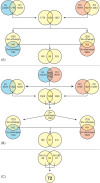A comparative chemogenomics strategy to predict potential drug targets in the metazoan pathogen, Schistosoma mansoni
- PMID: 19198654
- PMCID: PMC2635471
- DOI: 10.1371/journal.pone.0004413
A comparative chemogenomics strategy to predict potential drug targets in the metazoan pathogen, Schistosoma mansoni
Abstract
Schistosomiasis is a prevalent and chronic helmintic disease in tropical regions. Treatment and control relies on chemotherapy with just one drug, praziquantel and this reliance is of concern should clinically relevant drug resistance emerge and spread. Therefore, to identify potential target proteins for new avenues of drug discovery we have taken a comparative chemogenomics approach utilizing the putative proteome of Schistosoma mansoni compared to the proteomes of two model organisms, the nematode, Caenorhabditis elegans and the fruitfly, Drosophila melanogaster. Using the genome comparison software Genlight, two separate in silico workflows were implemented to derive a set of parasite proteins for which gene disruption of the orthologs in both the model organisms yielded deleterious phenotypes (e.g., lethal, impairment of motility), i.e., are essential genes/proteins. Of the 67 and 68 sequences generated for each workflow, 63 were identical in both sets, leading to a final set of 72 parasite proteins. All but one of these were expressed in the relevant developmental stages of the parasite infecting humans. Subsequent in depth manual curation of the combined workflow output revealed 57 candidate proteins. Scrutiny of these for 'druggable' protein homologs in the literature identified 35 S. mansoni sequences, 18 of which were homologous to proteins with 3D structures including co-crystallized ligands that will allow further structure-based drug design studies. The comparative chemogenomics strategy presented generates a tractable set of S. mansoni proteins for experimental validation as drug targets against this insidious human pathogen.
Conflict of interest statement
Figures

Similar articles
-
In silico repositioning-chemogenomics strategy identifies new drugs with potential activity against multiple life stages of Schistosoma mansoni.PLoS Negl Trop Dis. 2015 Jan 8;9(1):e3435. doi: 10.1371/journal.pntd.0003435. eCollection 2015 Jan. PLoS Negl Trop Dis. 2015. PMID: 25569258 Free PMC article.
-
Large-scale RNAi screening uncovers therapeutic targets in the parasite Schistosoma mansoni.Science. 2020 Sep 25;369(6511):1649-1653. doi: 10.1126/science.abb7699. Science. 2020. PMID: 32973031 Free PMC article.
-
The Schistosoma mansoni phylome: using evolutionary genomics to gain insight into a parasite's biology.BMC Genomics. 2012 Nov 13;13:617. doi: 10.1186/1471-2164-13-617. BMC Genomics. 2012. PMID: 23148687 Free PMC article.
-
Schistosoma mansoni genome: closing in on a final gene set.Exp Parasitol. 2007 Nov;117(3):225-8. doi: 10.1016/j.exppara.2007.06.005. Epub 2007 Jun 21. Exp Parasitol. 2007. PMID: 17643433 Review.
-
Tissue-specific transcriptome analyses provide new insights into GPCR signalling in adult Schistosoma mansoni.PLoS Pathog. 2018 Jan 18;14(1):e1006718. doi: 10.1371/journal.ppat.1006718. eCollection 2018 Jan. PLoS Pathog. 2018. PMID: 29346437 Free PMC article. Review.
Cited by
-
Combining bioinformatics, cheminformatics, functional genomics and whole organism approaches for identifying epigenetic drug targets in Schistosoma mansoni.Int J Parasitol Drugs Drug Resist. 2018 Dec;8(3):559-570. doi: 10.1016/j.ijpddr.2018.10.005. Epub 2018 Nov 13. Int J Parasitol Drugs Drug Resist. 2018. PMID: 30455056 Free PMC article.
-
Computational prediction of essential genes in an unculturable endosymbiotic bacterium, Wolbachia of Brugia malayi.BMC Microbiol. 2009 Nov 28;9:243. doi: 10.1186/1471-2180-9-243. BMC Microbiol. 2009. PMID: 19943957 Free PMC article.
-
A PAL for Schistosoma mansoni PHM.Mol Biochem Parasitol. 2010 Oct;173(2):97-106. doi: 10.1016/j.molbiopara.2010.05.009. Epub 2010 May 19. Mol Biochem Parasitol. 2010. PMID: 20488212 Free PMC article.
-
New research tools for urogenital schistosomiasis.J Infect Dis. 2015 Mar 15;211(6):861-9. doi: 10.1093/infdis/jiu527. Epub 2014 Sep 19. J Infect Dis. 2015. PMID: 25240172 Free PMC article. Review.
-
Defining the Schistosoma haematobium kinome enables the prediction of essential kinases as anti-schistosome drug targets.Sci Rep. 2015 Dec 4;5:17759. doi: 10.1038/srep17759. Sci Rep. 2015. PMID: 26635209 Free PMC article.
References
-
- Steinmann P, Keiser J, Bos R, Tanner M, Utzinger J. Schistosomiasis and water resources development: systematic review, meta-analysis, and estimates of people at risk. Lancet Infect Dis. 2006;6:411–425. - PubMed
-
- Hotez PJ, Molyneux DH, Fenwick A, Kumaresan J, Sachs SE, et al. Control of neglected tropical diseases. N Engl J Med. 2007;357:1018–1027. - PubMed
-
- Gryseels B, Polman K, Clerinx J, Kestens L. Human schistosomiasis. Lancet. 2006;368:1106–1118. - PubMed
-
- Herrera LA, Benitez-Bribiesca L, Mohar A, Ostrosky-Wegman P. Role of infectious diseases in human carcinogenesis. Environ Mol Mutagen. 2005;45:284–303. - PubMed
-
- King CH, Dickman K, Tisch DJ. Reassessment of the cost of chronic helmintic infection: a meta-analysis of disability-related outcomes in endemic schistosomiasis. Lancet. 2005;365:1561–1569. - PubMed
Publication types
MeSH terms
Substances
Grants and funding
LinkOut - more resources
Full Text Sources
Molecular Biology Databases

